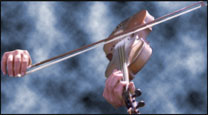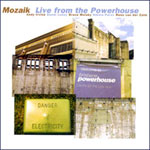
Welcome
to a site which celebrates music and culture from around the world
JigTime International
JigTime International

Mozaik - Live in New York
By Gwen Orel
 Maybe you're running out of friends to invite to Celtic
concerts…or
your boss has started saying, when you ask what cd to put on in the office, “not
Irish”—not that they don't like it but they think they've heard it before.
Well, here's a band you can invite ALL your music-loving friends to…the “world
music” fans especially. I brought an acquaintance trying to learn blues
guitar to hear them play in New York in April… with Tony
McManus playing
guitar I knew he'd find something to admire, even putting aside Bruce
Molsky's banjo and Andy Irvine's bouzouki.
Maybe you're running out of friends to invite to Celtic
concerts…or
your boss has started saying, when you ask what cd to put on in the office, “not
Irish”—not that they don't like it but they think they've heard it before.
Well, here's a band you can invite ALL your music-loving friends to…the “world
music” fans especially. I brought an acquaintance trying to learn blues
guitar to hear them play in New York in April… with Tony
McManus playing
guitar I knew he'd find something to admire, even putting aside Bruce
Molsky's banjo and Andy Irvine's bouzouki.
Mozaik is the most perfectly named band I have come across since Silly Wizard—it is a band made up of musicians whose traditions and styles are distinct, yet blend beautifully to form a cohesive work of art. And while spelling Mosaic with a “k”may have been Irvine's prosaic way of reusing the name for a different group of musicians than an earlier band he formed, the “k” itself vividly suggests something Eastern European and other.
I'll go hear Andy Irvine play wherever and in whatever tradition he chooses… and long-time fans of his from Planxty days will no doubt be aware that Irvine has been flirting with Eastern European melodies and rhythms for a long, long time. Nevertheless if you're a Celtic-music fan you might feel a fillip of anxiety; what will be the emphasis of this fusion; which flavors will stand out the most?
No need to worry. Everything harmonizes gorgeously. The album “Live from the Powerhouse,”just released April 2004, features Donal Lunny (also once of Planxty) on guitar; in concert this past spring Scottish virtuoso Tony McManus played instead. Though not quite so well-known perhaps as Lunny, McManus is a rare talent who sounds as natural playing a traditional Hebrew melody, a classical piece or an Irish jig. Other members of the band include Rens van der Zalm from Holland on fiddle, mandolin and guitar; the American old-timey musician Bruce Molsky on fiddle and banjo, and the Hungarian Nikola Parov on gadulka (a bowed rebec-type instrument), gajda (Bulgarian bagpipes), kaval (Bulgarian end-blown flute), tin whistle, clarinet, guitar and kalimba (African thumb-piano). Andy and Bruce alternate lead vocals, and everyone else chimes in on backing vocals.
In New York Mozaik performed at Satalla, a small club decorated in faintly downtown Indian style—low cushions and fluorescent paint (as well as a standard bar, tables and chairs). Andy greeted us by calling the crowd “small and select—we had you all vetted in advance.”
The band opened with “My Heart's Tonight in Ireland/Robinson County/the Trip to Durrow.” Several of the pieces played by Mozaik will be familiar to fans Planxty/Irvine fans including “the Blacksmith” (renamed “A Blacksmith Courted Me) and “Never Tire of the Road.” This is the third recording of the last tune, which appears on two previous solo albums by Irvine. But Mozaik's, for my money, is definitely the best—hearing it preceded by the old-timey “Pony Boy” and backed up with the Mozaik musicians is a revelation, and what could be more appropriate for a song about Woody Guthrie than banjo and fiddle? This version is almost most pumped-up --and it's a highlight of their performance, with its extended refrain. “All of you fascists bound to lose.” “Sing it!” Andy ordered, and we did…
The fiddle tunes “Rocky Road to Dublin/Indian Ate the Woodchuck” had what Andy called a “curious time signature”—4/4! (This is in contrast to the gorgeous pieces from Macedonia, one of which was described as “33/16—but who's counting.”) “Indian Ate the Woodchuck” includes the ringing tunes of 2 fiddles, 2 guitars and the flute… it's dynamic and exciting and lyrical, all at once.
Nikola played a haunting piece, “Sandansko Oro,” from Macedonia, explaining that like Ireland it was also a country that had faced oppression—for 500 years, in fact. The song celebrates 3 chieftans who fought and died in a 1903 rising. Using the gajda, then singing, the song was yearning and sad.
Tony McManus then played a piebroch from his solo album, and the rest of the band left the stage. This kind of tune he described as “normally quite tedious,” but it was anything but in his version, and blended seamlessly into a strathspey. How does he manage to make his guitar sound like resonant pipes?
And wasn't that Phil Cunningham (accordionist and composer, once of Silly Wizard, made a MBE for services to traditional music) kneeling down to take a picture of Tony when the tune got fast? It was! Irish singer Susan McKeown (who often performed with the late fiddle virtuoso Johnny Cunningham) was present as well. They didn't go up on stage, but maybe next time…
Then the group returned, and opened the second half with the “Field Hollar Medley,” in which Bruce Molsky sings and plays fiddle at the same time. This old-timey set was so rousing, including 2 fiddles and the kalimba, that a couple danced the jig to it by the bar, and there were a lot of “whoops!” and “heys!” heard. Really irresistible. The group got a standing ovation, and came back for an encore consisting of “The Blacksmith/Smithereens” and “Smeseno horo,” with Nikola on clarinet, in a sound that was like klezmer without exactly being klezmer, but was gentle, patient and compelling.
Don't miss this band when they come to your town… and you won't have to go alone…My blues-loving friend emailed me the next day to ask where he could get a cd… another convert!
 |